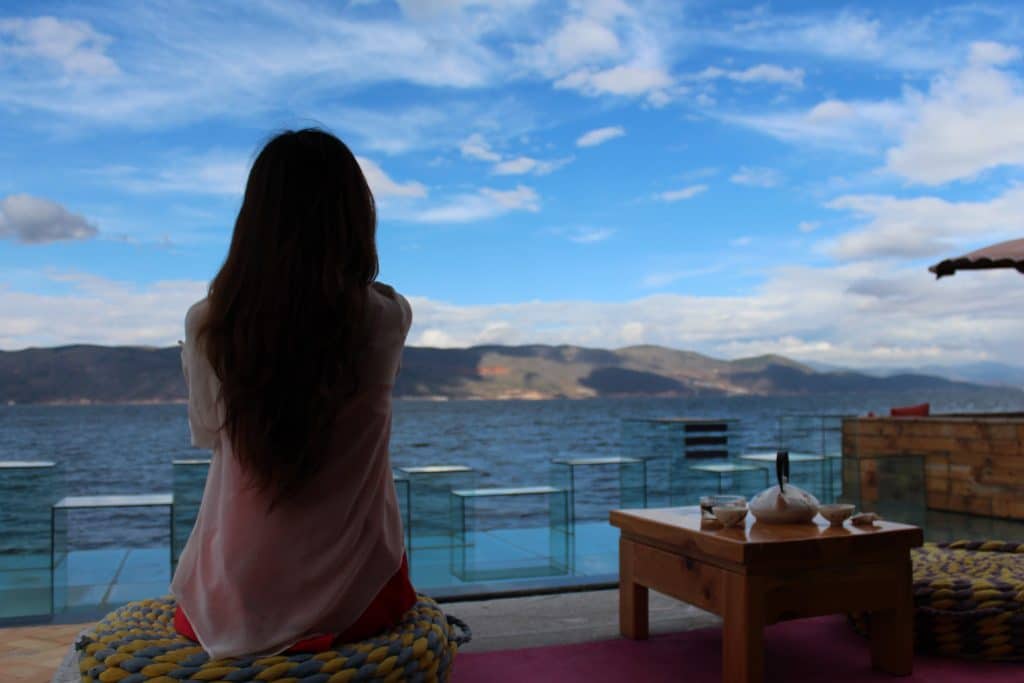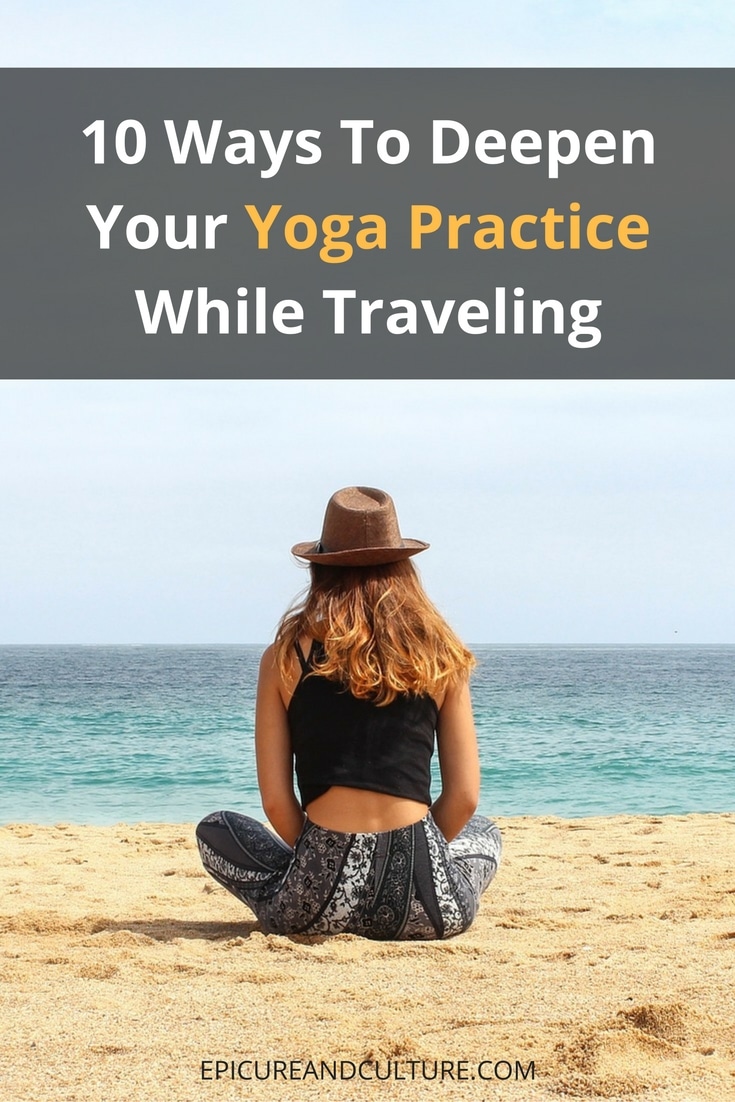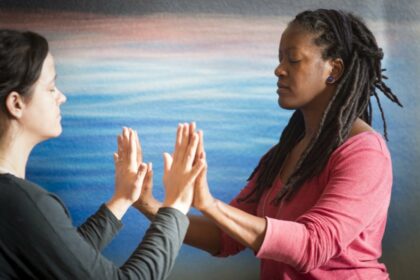
By Alexandra Samet of Hunger, Hatha & Heels; Epicure & Culture Contributor
Travelers are well-versed in exploration, hoping to get the most out of every experience.
Your yoga practice on the road should be no different.
Let’s take that curious and open-minded attitude towards exploring the world and adapt it on a journey towards self-discovery.
The following 10 avenues will help you with deepening your yoga practice.
1. Go Back To Basics
It’s amazing what yoga practitioners can do through ambition and steady practice.
While your sights might be set on advanced poses, sometimes to achieve the most challenging postures it’s important to begin with a solid foundation and build up to this through Krama, or stages.
One tactic for deepening your yoga practice is to attend a beginner’s class. You can even do this on the road while exploring wellness travel.
These classes usually focus on adjusting your alignment to ensure you’re doing poses correctly.
Classes that are all-levels or advanced usually assume participants know how to do a pose by mere mention of a posture name.
In reality, even advanced practitioners can injure themselves if they never take the time to learn the basics.
Pro tip:
A yoga retreat can be a great way to immerse yourself in the basics.
Looking for a little fun?
Check out these incredible yoga and wine retreats, enjoy one of these immersive vegan wellness retreats, or maybe book a few yoga adventures.
2. Start a Meditation Practice
Beginning a meditation practice can be daunting for many reasons.
For travelers who are always on the move, the thought of reserving even five minutes for thinking about nothing can induce anxiety.
Remember, though, this is the very purpose of yoga, whose definition is “the restraint of the modification of the mind-stuff.”
Moreover, yoga and meditation provide time by taking you into a clearer and more mindful headspace to be more productive throughout the day.
Despite misconceptions about meditation, it does not have to be done on a special pillow with your legs in lotus pose.
In Meditation For The Love Of It Sally Kempton suggests that the destination of meditation can be reached through many doorways, like chanting, visualization, and counting. Isn’t it reassuring to know you can experiment with various techniques and discover what works best for you?
It’s important to recognize that meditation is much more about the journey than the destination.
It is human nature to want there to be a reward for our efforts; however, meditation rewards those that have no expectations as the purpose is the practice itself.
In the Yoga Sutras of Patanjali it says “The pure, selfless desire has no expectations whatsoever, so it knows no disappointment no matter what the result. But though it expects nothing, it has its own reward.”
Here's how you can still dedicate #time to #yoga and #meditation when #traveling. Click To Tweet
3. Breathing Techniques
As significant as breathing is for well-being, people rarely spend time focusing on breathing correctly.
Many breathe shallowly without the use of their diaphragm, which doesn’t allow them to receive all the benefits of proper breathing.
In yoga, you breathe through your nose, keep your mouth closed, and experience deep and equal inhalations and exhalations.
Proper breathing allows you to bring more oxygen to the blood and brain, and control the prana, or energy life force, that allows you to control your mind and get into deeper poses.
You engage Ujjayi, or victorious breath, by constricting the back of the throat slightly and completing the action of fogging up a mirror.
This elicits an oceanic sound, which is mimicked by the ebbs and flows of the breath throughout the body.
You can take this breath with you as you encounter stressful situations on the road, allowing you to tackle obstacles with a calm and clear mind.
Whether your flight is delayed or your hotel can’t find your reservation, your breathing helps you focus on the present and not dwell on what’s outside your control.
Bonus:
This DIY program shares a sample yoga retreat schedule that includes breathwork and video tutorials.
4. Explore Mantra
Mantra is a sacred sound, syllable, word, or group of words in Sanskrit that is believed by many to influence your mind and spirit.
Many find some of their deepest yoga insights when practicing mantra. There are many to choose from, but the most popular is “Om” or “Aum” in Sanskrit.
The three letters correspond to three states of being. The A is the waking state, the U is the dream state, and the M is the state of deep sleep.
Try beginning and ending your practice with an “Aum,” and notice how the sound varies.
If you decide that mantra is not for you simply listen and understand the intention, which is to represent the beginning, middle, and end of your practice.
If you are a teacher or have your own home practice, you can use alternative techniques such as singing, storytelling, or reading a quote from a book.
The most important objective is that you open yourself up to various possibilities and ultimately decide what to take with you.

5. Don’t Take Yourself Too Seriously
Take note of how you feel when you are doing yoga on the road. Do you get frustrated easily if you cannot complete a pose? Are you quick to give up? Do you over-exert yourself?
Be mindful of your self-talk without judging yourself, and see what you can do to make this talk more positive. If you tell yourself you are amazing, capable, and that you are having fun with your practice, this will become a self-fulfilling prophecy.
Take this positive self-talk into your daily life, as well. Smile as you walk down the street, commend yourself for your accomplishments, and perceive obstacles as a mere hurdle to get to some place better.
Love #travel and #yoga? Here's how you can do both at the same #time. Click To Tweet6. Spiritual Awareness
As sportswear companies market curve-hugging yoga pants and colorful sports bras, and magazines flaunt fit bodies with yoga mats tucked over their shoulders, the true meaning behind yoga can sometimes get lost.
Yes, yoga can be an excellent form of exercise, and fun clothing and accessories can make you feel good about yourself; however, it’s important to recognize the spiritual side of yoga.
It’s up to each individual how spiritual they wish to be, but understand yoga emerges from the Hindu religion as an avenue to spiritual enlightenment.
While it emphasizes the value of believing in something larger than ourselves, its spiritual principals are mainly focused on being compassionate towards yourself and others. This compassion includes being open to spiritual practices though only taking in what feels truthful to you.

7. Create a Sacred Space For Your Practice
To be more centered when you are on the road, create an inviting space that will encourage you to keep up with your daily practice.
Perhaps bring along some small items with sentimental value to you like photos, stones with inspiring words or candles, or find these items once there.
You can use a small side table or a stool to display your items.
There is no right way to set up your space; simply make it your own and consider what will make you feel the most centered.
8. Use Props
For some people accepting help can feel like a failure; but by refusing help you may not be deepening your yoga practice.
Rather than making challenging poses harder than need be, why not utilize props like blocks, straps, and bolsters?
Even advanced practitioners can benefit from props for certain poses. If you need help binding, utilize a strap to connect your hands. If your hips are tight, sit on a block.
Remember that yoga is about finding balance between rajas (effort) and tamas (ease) to ultimately reach satva (enlightenment).

9. Embrace Your Truth
It has been said that you cannot move toward wholeness if you are caught up in lies. Patanjali once said that lies make us suffer.
Therefore we must practice Satya, or living the truth. This means we’re actively becoming the truth by thinking the truth, saying the truth and representing who we are in the most honest light.
During asana, or yoga postures, you can embrace your truth by looking internally and thinking about whether a certain pose is helpful in finding balance.
Living your truth may be to turn off the desire to always go for the more challenging pose and to instead think about what is safe and/or helpful for your body in that moment.
Challenge: do an activity that is outside your comfort zone, like dancing wildly in public. This can help you tune out noise around you and feel free to be who you are.
10. Yoga Teacher Training
Having graduated from a 200-hour yoga teaching certification program, I can attest to the benefits. Whether or not you are planning to be an instructor, this type of training can be invaluable for deepening your yoga practice.
If you are on the road there are various retreats as well as online yoga teacher training that offer an expedited version of the program.
You learn the human anatomy, which can help you complete poses in ways that are benefiting your body. You become more in tune with how your breathing and postures coincide.
You learn about the history of yoga and sacred texts that can help you further understand the purpose of your practice. You learn everything from chakras to chants to sun salutations to alignment cues.
Like everything else in your practice, you absorb what you find valuable and take that on your individual journey.
What advice would you add for deepening your yoga practice? Please share in the comments below!
Bonus Yoga Retreat Resources
15 Amazing Vegan Yoga Reteats For Plant-Based Wellness
6 Important Questions For Choosing A Responsible Yoga Retreat
15 Best Surf And Yoga Retreats In Bali, Indonesia
15 Best Transformative Yoga Adventures Worldwide
How To Enjoy A Silent Meditation Retreat In Mexico
15 Incredible Yoga & Wine Retreats Around The World
15 Best Yoga And Hiking Retreats Around The World
15 Best Mallorca Yoga Retreats
15 Best Caribbean Wellness Retreats & Resorts
15 Best Surf And Yoga Retreats In Portugal
Alexandra Samet
Latest posts by Alexandra Samet (see all)
- 10 Effective Ways To Deepen Your Yoga Practice While Traveling - Jun 19, 2020
- How To Combine The Benefits Of Yoga With Giving Back - Nov 29, 2016
- How To Discover Your Dosha For Life Balance On The Road - Aug 3, 2016






I really liked the idea of setting up your corner for daily practice as when we are travelling we find it hard to find a suitable inviting place. I will definitely try this technique!
Awesome! This article is very informative and very good. Thanks for sharing this with us. Keep sharing.
Very Awesome and Help full Article. It really helps me. thanks for sharing this.